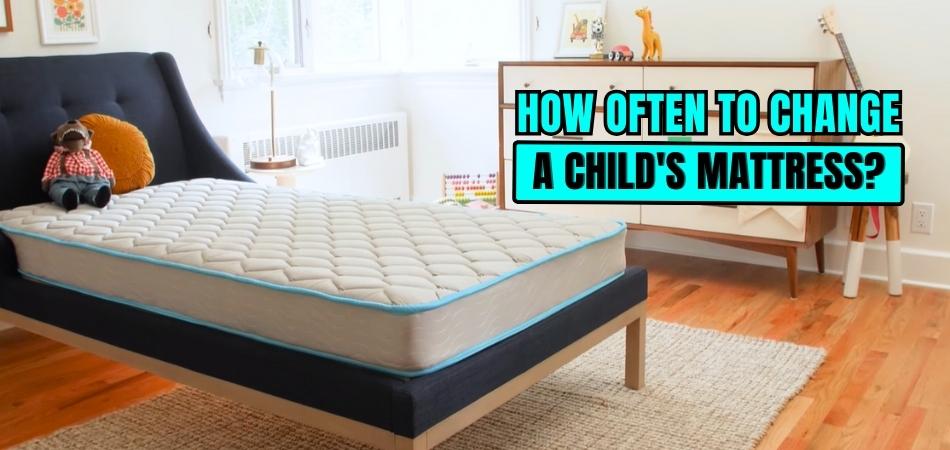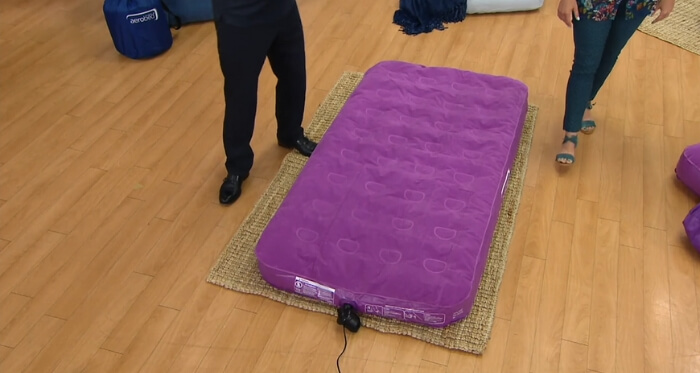Children need extra care due to their developing bodies and vulnerability. Their growth, immune systems, and sleep patterns require specialized attention to ensure they thrive physically and emotionally. Providing a supportive environment, including a suitable mattress, is crucial for their overall well-being. But do we know where and when children require more care?
Sleep and food quality, timetable, and management are the factors that we need to focus mainly on for a child. Good food is for health, and quality sleep is for a better mood.
A mattress is the best way to enhance our children’s sleep quality. It provides comfortable sleep every time and helps improve physical and brain function. That’s why anyone needs to know the answer to this question: How often do you need to change a child’s mattress?
The right time to replace your child’s mattress is every three to five years. But mostly, the period depends on the child’s age, usage, and other factors. This article will walk you through each term and let you understand what’s the right time to change your kids’ mattress.
How Often Do You Need to Change a Child’s Mattress?
Maintenance of a mattress vary depending on a child’s age and the appearance of the mattress. That’s where the question arises: How often do you need to change a child’s mattress?
Every mattress is designed with specific materials and fabric that maintain the quality. Depending on the materials, a mattress can last almost ten years, and the higher the price, the higher the quality of the materials.
Moreover, a mattress’s lifespan also varies depending on the maintenance of its users. If you can take good care of your mattress, clean it daily, remove the spill stains instantly, and keep hazardous objects away, the mattress could last more than 10 years.
Usually, we replace a mattress when it’s torn, older, and becomes uncomfortable for sleeping. But the period of replacing our child’s mattress is not similar to the adult’s mattress.
Mostly, it depends on the life stage of our children. Generally, the mattresses of two to six year old children must be replaced every three years. For children from five to ten years or more, the mattress replacement time is after every five years.
Signs When Should We Change Child’s Mattress
Many signs appear when it’s time to change your child’s mattress. But a regular inspection is a must to find out the signs. However, here I will demonstrate some common signs of when you should change your child’s mattress.
Damage from use
Wear and tear is a common issue that appears from long-term use. If your child has been sleeping on the same mattress for many years, then stains, sagging, lumps, holes, etc will indeed appear. If you find any of these faults in the mattress inspection, replace the mattress immediately.
Sagging
Sagging is the most apparent sign when a mattress is begging for replacement. Sagging and lumps in various places of the bed occur after prolonged use.
This condition of the mattress will not allow your child to sleep comfortably. More importantly, you can’t fix the sagging issue, and an immediate replacement will be required.
Sleep pattern changing
Lumps in different areas of the mattress and often uneven surfaces disturb our children’s peaceful sleep. If the sleeping surface is not suitable, they can’t sleep like before, and this will change their regular sleep pattern.
It is another noticeable sign when your child’s mattress requires replacement. Sleep is the most essential part of our children for their perfect growth and overall well-being.
Health issues such as allergies and asthma
Every mattress is made with various materials and fabrics to maintain quality, durability, and sustainability. However, low-quality mattress materials often contain allergic extracts such as pollen, fungi, and arthropods.
Those who have allergy conditions, these allergy substances could become a dangerous health problem. If your children have allergy symptoms, check the mattress materials and change them as soon as possible.
Body Growth
Growth varies from person to person. If your child has outgrown and become taller than their bed, it’s time to change it. How will your children sleep comfortably if their leg is out of the mattress?
A sufficient space is always required to get optimal sleeping convenience. Replace the mattress and get a new one with adequate height, according to your child.
These are the most visible signs of a replacement required mattress after a good use time. But there might be more cases where a bed needs to be replaced after a few use times.
The use period doesn’t matter, but the signs and the condition of the child’s mattress are responsible for the replacement. A suitable sleeping surface is essential to keep our sweet toddler’s health and mind fresh and developed.
How to Expand the Lifetime of a Child’s Mattress?
Expanding the lifetime of a child’s mattress doesn’t mean you could use it forever, but some changes might improve the sleeping quality and our child’s overall health. Let’s see what we could do to let our children use the same mattress more often than usual.
Fits Properly
Fitting the mattress properly in the bed frame or the crib is the foremost need to expand a mattress’s lifespan. A perfectly suited mattress provides stability and reduces sagging and lumps issues. Double-check while you’re installing your child’s mattress or now and then.
Stain Resistance
Stains are one of the general reasons that make a mattress seem dirty. A dirty surface can never be a suitable place for relaxation. A stain-resistant cover or mattress protector can relieve us of this issue.
Moreover, a stain-resistant mattress cover is easy to wash and keeps the surface neat. Consider buying a mattress protector to elevate the mattress’s quality and lifetime.
Liquid Resistance
Babies have accidents, and it is obvious. Spilled foods or liquid items create stains on the mattress and often smell. Peeing is another reason why a child’s bed stinks more than usual. This fact is unavoidable, but integrating a waterproof mattress cover will reduce odor production as these are very easy to wash.
A waterproof and washable mattress cover or protector reduces unpleasant smells and keeps your child’s health at maximum height.
High-quality Material and Flexible
A toddler mattress with high-quality materials that provide flexibility will undoubtedly last long. A flexible bed ensures peaceful and comfortable sleep overnight and reduces sagging. That’s why purchasing a mattress manufactured with the best quality materials is recommended to experience the finest service. These can last longer and provide better support over time. High-quality materials and construction can extend the mattress’s lifespan.
Furthermore, a good quality mattress lasts long. But these are often expensive. Investing in something that I can use in a lone run and whose quality will remain the same is worth investing in.
Regular Maintenance
Maintenance is a mandatory need for anything. But regular upkeep on your child’s mattress, such as washing the stains, removing the odor, and sweeping dust and dirt, will expand the lifetime of a child’s mattress.
Those with busy schedules can maintain their toddler beds once a week or twice a month to keep the mattress’s quality and the child’s sleeping comfortably. Rotate the mattress regularly to ensure even wear and consider using a mattress protector to extend its life.
Why Is It Essential to Change a Child’s Mattress?
There is a medical saying, “Sleep is the golden chain that ties health and our bodies together”, which strongly establishes how vital sleep is for our bodies. It is even more essential for children to develop their immune system, mental growth, and emotions.
A child should sleep at least 9-10 hours per day. But what if the sleeping surface is inappropriate for their comfortable sleep and health?
If your child complains of discomfort, it may be time to evaluate their mattress for potential replacement.
Various physical, cognitive, and emotional symptoms will appear, such as difficulty waking up in the morning, tired all day, blurry vision, lack of interest, attention, moodiness, stress, etc. Only proper sleep can keep a child’s mental and physical health at its best. Over time, mattresses can accumulate allergens like dust mites, which can be problematic for children with allergies or asthma. Regular cleaning and using mattress protectors can help, but eventually, replacement is necessary
So, to keep your child’s health in the best condition, you must replace your child’s mattress periodically after 2-5 years or if any signs occur. A firm and fresh sleeping surface will enhance a child’s sleep and overall well-being.
What Mattresses Are Best For a Child?
A crib board is a traditional choice for a child’s bedding option. It is a safe yet effective sleeping place for a child. But regarding portability and convenience, an air mattress is the ultimate bedding choice for children.
Children often want to sleep in their parent’s room, and an inflatable mattress will ensure your lovely child has a proper sleep even after changing the place.
Moreover, if we talk about allergenic properties, an air mattress is only made with one layer of polyvinyl chloride, free from any allergenic components.
Air mattresses are easy to use and maintain. You can wash them whenever your child accidentally spills something, and the upper surface is mostly stain-resistant.
In addition, air mattresses are firm and soft, ensuring a comfortable sleep for your child that is necessary to develop their health and growth. The most promising thing about these mattresses is they are budget-friendly.
You can buy even the best kids air mattress for only $60, which is two to three times less than a crib board and mattress price. Air mattresses are not budget-friendly, but they reduce the hassle of frequently changing a child’s mattress.
From all aspects, from versatility to convenience, air mattresses are the best bedding option for children to improve their sleeping quality and lessen the hassle of replacing mattresses.
Conclusion
Are you still in doubt about How Often Do You Need to Change a Child’s Mattress? A child’s mattress has no ideal lifespan, but replacing it after three to five years from the day of use is recommended.
However, the lifespan of a child’s mattress usually depends on how often we maintain it and how roughly our children are using it. Regular maintenance will expand the longevity of our child’s bed.
If your child can walk or does not need a crib board bed, then air mattresses are the best bedding option. These mattresses are convenient to use, portable, and easy to maintain.
Moreover, kids find it fun to spend their time on an air mattress because of its softness and swing. Also, different shapes of air mattresses are available, especially for kids.




